Use this simple guide to render fat into tallow and master this important homestead survival skill. Tallow can be used in soap making, for bird feeding, fire starter, and more. Depending on the fat source, this same technique can be used to render lard.
Knowing how to render fat into tallow is an important homestead survival skill. Rendered fats can be used for soap making, cooking, baking, conditioning leather, candle making, and as fire starter. Rendered fats are stable, safe for storage, and won’t go bad if kept in cool or cold storage.
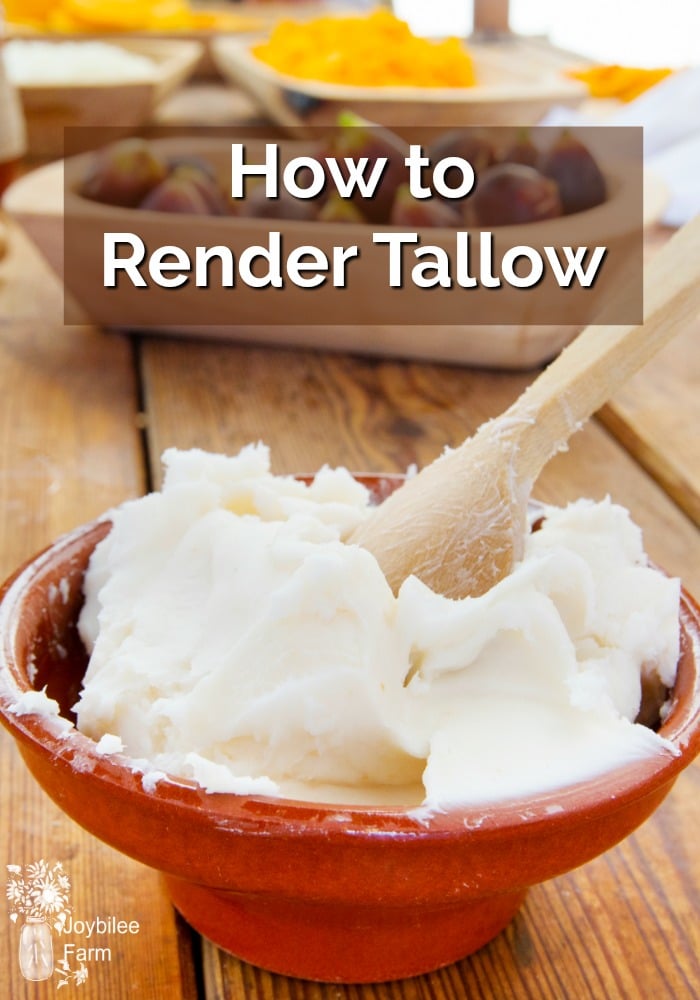
Different Animal Fats
Animal fat is a valuable substance. In commercial meat processing, animal fat is sent to a rendering plant to be rendered into animal feed. On the homestead, you can render fat on your kitchen stove or better yet on the wood-stove (free heat source). Beware that rendering fat will fill the house with the smell of roasting meat, some find the smell nauseating. So if you are sensitive to smells you may want to do this in an outdoor kitchen.
Fat from goats, sheep, llamas, alpacas, deer, moose, elk, caribou and other ungulates is hard and when rendered is called tallow. Fat from pigs, bear, and rabbit is soft fat, and when rendered is called lard. Fat from poultry such as duck, geese, and chickens is called “schmaltz” and is soft, almost liquid, at room temperature. The fat is rendered the same way regardless of the animal that it comes from. Softer fats render faster, and fats from different animals should be rendered separately.
The harder fats make a very good soap for laundry and other household cleaning products. It can be used as a bathing soap, as well, and is a good grease cutter. However, most bathing soap these days includes coconut oil and olive oil which provide luxurious lather, as well as skin moisturizing qualities. Hard fats can also be used as suet for winter bird feeding, suet isn’t needed to feed summer birds, like hummingbirds. Softer fats are good for pastry and baking purposes.
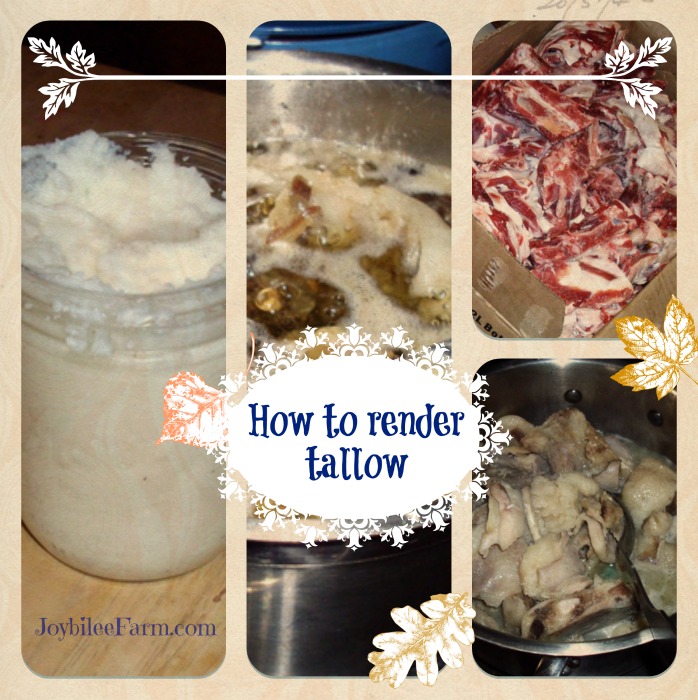
How to render fat into tallow
Equipment:
To render fat into tallow or lard you will need:
2 Large stock pots with lids
A long handled spoon to stir the pot
Fat pieces which have been cleaned of residual organ meat. Muscle meat is all right, just keep meat to a minimum.
Small amount of water
Heat source
Procedure to render fat into tallow or lard
To render fat of any kind, including beef suet, fill 1 stock pot ½ full of cut up fat. The fat may have some meat scraps and perhaps bone attached. This is not a concern. If the fat is from the inner organs, such as around the kidneys (the highest quality fat), remove the kidneys and organ meats before rendering or the final fat will smell off.
Add enough water to cover the bottom of the pot to 1 inch. This will help transfer heat to the fat and prevent burning. Put the pot over medium heat and heat thoroughly. Stir the fat once or twice until it becomes translucent, to keep it from sticking to the bottom of the pot and burning. As it continues to heat the fat will become liquid and the chunks will shrink. The liquid in the pot will begin to bubble and the water will evaporate. Continue stirring occasionally to transfer the heat to all parts of the rendering fat. Once all the water is evaporated the temperature will rise. At this point you can remove any bones that made it into the pot, with your long handled spoon, and put them aside for another purpose.
As the fat begins to render, you can add more pieces of fat to the pot. However, don’t fill the pot more than 3/4s full. As it heats the fat will expand and you don’t want the hot fat to boil over onto your stove, or other heat source.
Caution:
Fat is flammable and boiling fat can smoke and catch fire. At this point, in rendering, watch it for smoking. You don’t want to let the pot get to the smoking point or you can have a flash fire. If you see any smoke, remove it from the heat source immediately, and cool it down before proceeding.
Never use water on an oil fire. Keep your pot lid handy, and if a fire starts, slip the lid over the pot from the edge to deprive the fire of oxygen slowly. If you slam the lid onto a flaming pot, it may not starve the fire of oxygen and it can continue burning under the lid. Turn off heat source without moving the pot, if possible, and let cool. Fat that has flared is still safe to use, just make sure the pot has cooled down enough to not re-flare before you remove the lid, or turn back on the heat source.
The pot will need to bubble gently (simmer) for several hours until all the fat has become liquid and the water in the meat has evaporated. The meat will be hard and crunchy – usually referred to as cracklings. This can take all day or even several days, depending on how big your stock pot is.
Remember, don’t leave the pot unattended on the heat source. I will remove the pot overnight and resume the heating in the morning if necessary.
Clarifying the fat for clean tallow
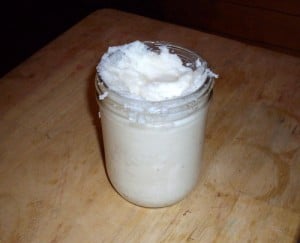
Place pot on heat source and bring to a boil until the whole pot is liquid. Remove from heat and allow to cook completely. The fat at the top of the pot will harden and can be lifted out in a solid piece. The bottom will be covered in a wet, grey slimy sludge. Scrape or cut this off and feed it to you poultry. It’s the coagulated blood from the rendering process, and it is full of protein. The clean white fat is your finished tallow. I like to melt it one more time and then pour it into wide mouth canning jars, or other storage containers. Cover jars with the 2 piece lids and store without processing. These do not need to be sealed. All water is removed during the boiling process and the tallow is clean of impurities.
Your finished tallow can be used as you would lard, although it will be a bit harder than lard for pastry baking. It can also be used to make soap. Candles can be made with hard tallow or a combination of tallow and bees wax. Pine cones dipped in tallow and then allowed to harden, make easy fire starters. Rendered tallow can be used for bird food to feed insect eating birds like woodpeckers and flickers.
At our house the chick-a-dees will perch on the kitchen window to get our attention when the suet feeder is empty. Once we fill it they come back one more time to say, “Thank you”.
Your Turn:
What animal fat(s) have you rendered? How have you used tallow, suet, or lard? Leave a comment.


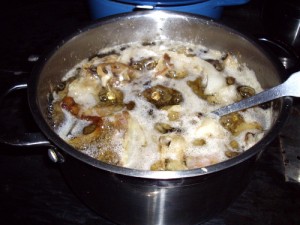
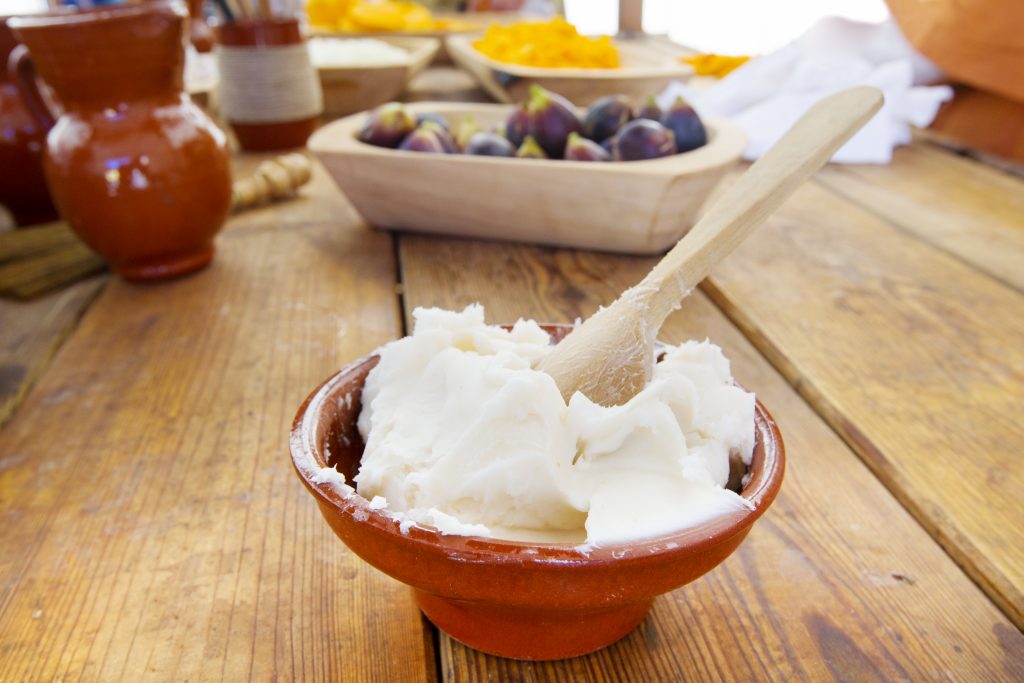

You can clean the tallow once its done rendering by placing it in a clean pot and adding some water (about equal to the amount of fat). Then melt it. The blood will fall to the bottom of the water and the oil will float. Let it harden. Turn the fat over and scrape any brown bits off. You will have clean white tallow.
I am in the process of rendering some beef fat currently. I noticed as the fat broke down in the crockpot there was still a decent amount of kidney and blood in the center of the fat. Will this affect the tallow negatively as long as I follow the rest of your steps?
I hate to waste this batch but can chalk it up to a lesson learned.
A crock pot might be more fool proof. You can at least melt the fat at a lower temperature and avoid burning. I get that its hard to keep an eye on it near the end of cooling time though.
Good ideas for what to use burnt tallow on? Lol
Suet and what else?
Sigh.
I’ll just Try again!
Yes